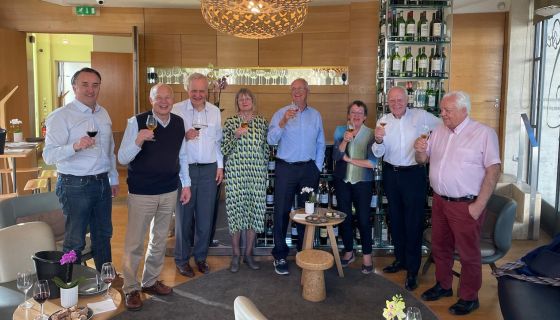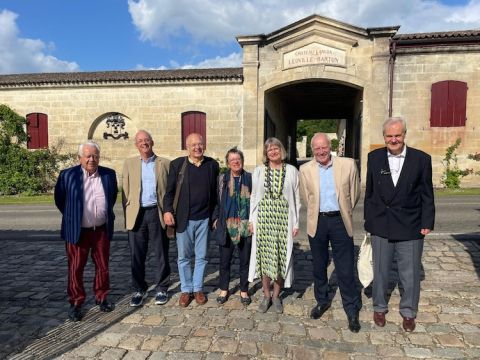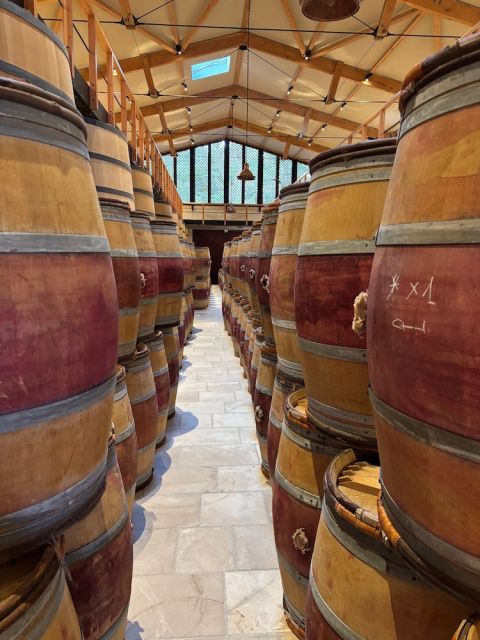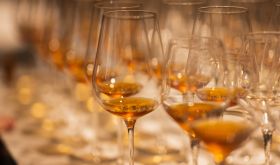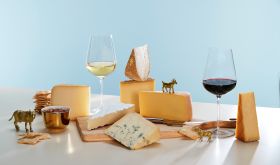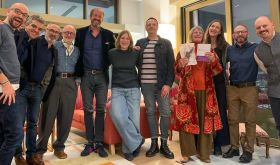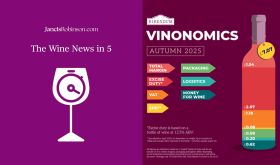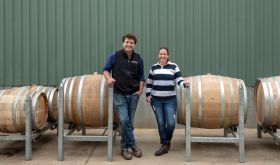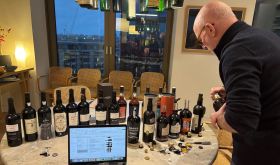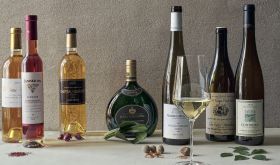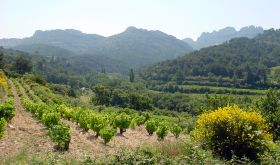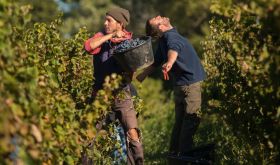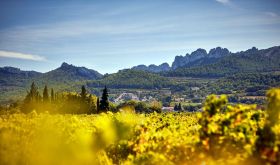My two days in Bordeaux earlier this month were pretty sobering. Our small group of UK wine professionals born in 1950 arrived the day after a vigneron two decades younger than us, in the decidedly superior Castillon appellation, died by suicide. He was one of hundreds of vignerons whose life was devoted to growing grapes that nowadays no one seems to want.
Problems in the lower reaches of the Bordeaux quality pyramid have been evident for some time, with the result that some of the wine world’s best value is to be found here. But now the top end is in serious trouble, too. ‘Bordeaux is at an inflection point’, Charles Sichel told us over our first lunch, at Château Palmer in Margaux. The Sichel family is the largest shareholder of this famous classed growth and also owns a substantial négociant, so straddles the divide between Bordeaux’s producers and the merchants who sell their produce.
First growth Château Lafite 2024 had been offered en primeur (see below) almost three weeks before at what looked like a knockdown price, cheaper than any other vintage currently available (which has too rarely been the case with recent en primeur campaigns). And yet the négociant Maison Sichel had not yet sold out of its allocation. ‘It used to be a matter of minutes’, sighed Sichel.
The London fine-wine trade has over the years played a crucial part in selling the latest vintage to other merchants, and to individuals for investment. But this year those traders I have spoken to confirm that only one wine has sold truly successfully. Château Les Carmes Haut-Brion, a Pessac-Léognan in the southern suburbs of Bordeaux (shown on this World Atlas of Wine map), has developed a cult following for its non-traditional, rather burgundian winemaking and wine heavily dependent on Cabernet Franc grapes, which generally yield a lighter, more aromatic wine than Cabernet Sauvignon, the characteristic grape of the Médoc north of the city where the famous classed growths are concentrated.
Also in Pessac-Léognan and almost in the southern suburbs of Bordeaux is Château Brown, owned by the Mau family who used to run one of the biggest Bordeaux négociants Yvon Mau. Jean-Christophe Mau told us that his 2024 red had been released en primeur the day before our visit, at well under €20 a bottle, and that he expected it to take a month to sell through.
Will the en primeur system continue, I asked him. His answer was an emphatic No! ‘Maybe for about 15 of the top châteaux, but even Lafite didn’t work this year. Next month the top châteaux will have a big cash problem. Négociants can refuse to buy, but châteaux can’t turn off the tap.’
I assume he was referring to the lack of primeur income to cover the cost of producing the 2025 vintage. But at every property we visited we were struck by the lavishness of recent investments in cellars, offices, reception rooms and the like. All of this was tax-efficient, presumably.
Charles Sichel again: ‘We expected a difficult campaign but not one as bad as this. The prices have been right for most châteaux, meaning lower than available older vintages, but Pontet-Canet was a massive let-down.’ This Pauillac classed growth had hosted a big dinner for le tout Bordeaux trade just before the campaign launched last month. ‘There was lovely food and wine, and just a great buzz. We were all expecting Pontet-Canet to kickstart the campaign the following week. But they got the price wrong – higher than the current price for the 2020 and 2021 vintages – so it didn’t work, although others learnt from that and did reduce their prices enough. In theory.’
One of our number had worked with the Sichels in his youth and remembered how the 1973 vintage of Palmer was not priced by the bottle, as en primeur is today, but sold in bulk, with buyers paying the eventual bottling costs. It was offered just after the oil crisis when you could hardly give bordeaux away. Indeed, Palmer did give it away. Anyone buying a tonneau (900 litres) of the 1973 was offered a second one free, so long as they paid the cost of bottling both of them when the time came. On hearing this, Sichel, too young to have known that era, declared only half joking, ‘It could happen again!’
One of the problems of Bordeaux’s tight-knit wine community is that it tends to console itself by remembering that the wine trade has been through many an up and down, so the assumption is that everything is cyclical and all will come right in the end.
But this time, the threat really does feel existential. Traditional customers are getting older and have full cellars. They are not being replaced. Such younger people as are interested in wine have so many more wines to choose from than the slow-maturing reds of Bordeaux that, ideally, need many a year in a cellar racking up storage costs before they show their best.
Bordeaux now has a store, Belles Grappes, specialising in no- and low-alcohol drinks and Dry January has been adopted by the French, we were told by Christophe Château, the communications director of the Conseil Interprofessionnel du Vin de Bordeaux (the Bordeaux Wine Council), who also pointed out that annual per capita consumption of wine in the year we were born was 124 litres. Just before lockdown gave it a little boost, that figure was 40, and it’s expected to sink to 30 before long.
Dry white bordeaux and sparkling Crémant de Bordeaux are offering lifelines to some producers, especially those in the Entre-Deux-Mers region where the great majority of the grubbing up of red-wine vines has been concentrated. And with reds there are widespread efforts among producers to tame tannins, lighten alcohol levels, and switch from oak ageing to fashionable, and gentler, clay or concrete.
The négociants have come up with a way to soften the financial blow of selling much less bordeaux en primeur. Back in 1998, despite considerable opposition from some other château owners, the owners of first growth Château Mouton Rothschild began to sell Almaviva, the Chilean Cabernet they produce with Concha y Toro, through the négociants on the marketplace known as La Place de Bordeaux. Opus One, the (Mouton) Rothschilds’ joint-venture Napa Valley Cabernet, eventually followed suit, as did Masseto, a rich Tuscan Merlot. They have been joined since then by a host of non-Bordeaux wines, by no means all of them tip-top in terms of quality and reputation. But at least they help the négociants’ balance sheets every September.
According to Sichel, many of the négociants are thinning their portfolios of these ‘Beyond Bordeaux’ candidates, for only a portion of them sell successfully enough to warrant the effort. ‘It’s a bit like floating on the stock market. If no one’s ever heard of you, it doesn’t work. It works only if you have successful distribution in the first place.’ This makes me, for one, feel sorry for the individual distributors who have worked hard building up brands’ reputations, only to find the brand owners scurrying off to La Place de Bordeaux, which does nothing for reputations, just spreads the wine thinly far and wide.
There is one Bordeaux product that is in demand, however. During a tour of the spanking new cellar responsible for Châteaux Langoa Barton and Léoville Barton (whose pricing has always been relatively modest considering their popularity), we came across a stack of 60 used, crimson-belted barrels looking very much more distressed than the brand-new ones that populate most of the famous cellars in the Médoc.
They were destined for Midleton Distillery in County Cork in Ireland, where Green Spot whiskey would be aged in them, its packaging heavily branded Château Léoville Barton and the liquid described as ‘Bordeaux finish’. (See Dave Broom's excellent article about the renaissance of Irish distilleries.)
Good-value bordeaux
A selection of the 220 Bordeaux wines in our database that are drinking well now and I reckoned were especially good value, no matter what the price, when I tasted them.
Dry white
Château Chantegrive, Caroline 2016 Graves 13%
£14.95 The Wine Society
Reds
Château Larrivaux 2019 Haut-Médoc 14%
£20.40 Haynes Hanson & Clark
Château Mauvesin Barton 2018 Moulis-en-Médoc 13.5%
£23.35 Haynes Hanson & Clark
Château Ferran 2019 Pessac-Léognan 14.5%
£26.25 Haynes Hanson & Clark
Château Capbern 2016 St-Estèphe 14%
£29 Wine Trove, £35.28 Four Walls Wine Company
Château Canon, Croix Canon 2016 St-Émilion 14%
£33.85 Justerini & Brooks
Château Cantemerle 2014 Haut-Médoc 13%
£34.99 Marlo
Château Lalande Borie 2016 St-Julien 13.7%
£35 Street Wines
Château Le Boscq 2016 St-Estèphe 13.5%
£42.84 Four Walls Wine Company
Sweet whites
Château La Tour Blanche 2016 Sauternes 13.5%
£60 Millesima UK
Château Rieussec 2009 Sauternes 13.5%
£61.20 Four Walls Wine Company
Château Coutet 2001 Barsac 14%
£61.20 Four Walls Wine Company
Back to basics
| What is en primeur? |
|
Bordeaux’s en primeur campaign takes place every spring when each château above a certain quality level announces per-bottle prices for their latest vintage. This means that the wines are only a few months old and still in cask. They won’t be bottled until well into the next year, and the final blends may not even have been made. Despite this, critics and merchants are encouraged to visit Bordeaux to taste and rate the young wines before prices are released, preferably as enthusiastically as possible.
The en primeur system, which started in the late 1970s and only really took hold from the 1980s, worked well when demand exceeded supply and en primeur prices were considerably below what the wine would cost once it was in bottle. Many a collector would have their favourite wines and build up their cellar based on these en primeur purchases. It was a common tactic, in a rising market, to resell a certain proportion of the wine to fund future purchases.
But, fuelled by new-found interest from Asia, château owners dramatically overpriced the 2009 and 2010 vintages and since then it has become harder and harder to justify buying en primeur on financial grounds, especially since many vintages have been released at prices in excess of those of mature vintages on the market. 2021 was especially overpriced. |

